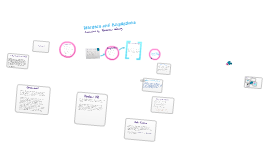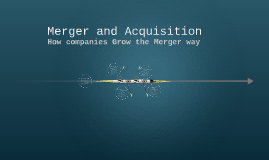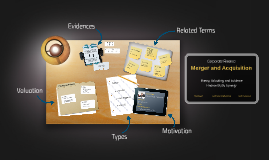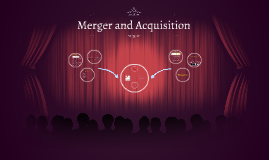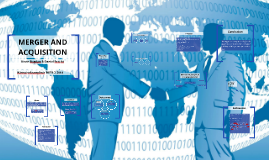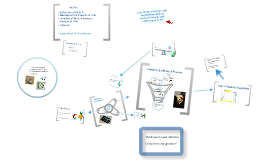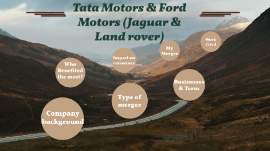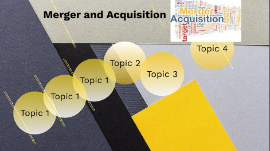Merger and acquisition
Transcript: Tata Motors & Ford Motors (Jaguar & Land rover) Company Background Company background JAGUAR Jaguar Cars was the company that was responsible for the production of Jaguar cars until its operations were fully merged with those of Land Rover to form Jaguar Land Rover on 1 January 2013. Jaguar's business was founded as the Swallow Sidecar Company in 1922, originally making motorcycle sidecars before developing bodies for passenger cars. The company's name was changed from S. S. Cars to Jaguar Cars in 1945. A merger with the British Motor Corporation followed in 1966, the resulting enlarged company now being renamed as British Motor Holdings (BMH), which in 1968 merged with Leyland Motor Corporation and became British Leyland, itself to be nationalised in 1975. Jaguar was spun off from British Leyland and was listed on the London Stock Exchange in 1984, becoming a constituent of the FTSE 100 Index until it was acquired by Ford in 1990. Ford owned Jaguar Cars, also buying Land Rover in 2000, until 2008 when it sold both to Tata Motors. Tata created Jaguar Land Rover as a subsidiary holding company. At operating company level, in 2013 Jaguar Cars was merged with Land Rover to form Jaguar Land Rover Limited as the single design, manufacture, sales company and brand owner for both Jaguar and Land Rover vehicles. Jaguar Cars was the company that was responsible for the production of Jaguar cars until its operations were fully merged with those of Land Rover to form Jaguar Land Rover on 1 January 2013. Jaguar's business was founded as the Swallow Sidecar Company in 1922, originally making motorcycle sidecars before developing bodies for passenger cars. The company's name was changed from S. S. Cars to Jaguar Cars in 1945. A merger with the British Motor Corporation followed in 1966, the resulting enlarged company now being renamed as British Motor Holdings (BMH), which in 1968 merged with Leyland Motor Corporation and became British Leyland, itself to be nationalised in 1975. Jaguar was spun off from British Leyland and was listed on the London Stock Exchange in 1984, becoming a constituent of the FTSE 100 Index until it was acquired by Ford in 1990. Ford owned Jaguar Cars, also buying Land Rover in 2000, until 2008 when it sold both to Tata Motors. Tata created Jaguar Land Rover as a subsidiary holding company. At operating company level, in 2013 Jaguar Cars was merged with Land Rover to form Jaguar Land Rover Limited as the single design, manufacture, sales company and brand owner for both Jaguar and Land Rover vehicles Land Rover LAND ROVER Land Rover is a British brand of four-wheel drive cars that exclusively offers premium and luxury sport utility vehicles. Owned by multinational car manufacturer Jaguar Land Rover (JLR), which has been owned by India's Tata Motors since 2008, JLR currently build Land Rovers in Brazil, China, India, Slovakia, and the United Kingdom. The Land Rover name was originally used by the Rover Company for a boxy four-wheel drive, off-road model, launched in 1948—now known as the Land Rover Series, it is today regarded as a British icon. Over time, Land Rover grew into its own brand (and for a while also a company), encompassing a consistently growing range of four-wheel drive, off-road capable models. Starting with the much more upmarket 1970 Range Rover, and subsequent introductions of the mid-range Discovery and entry-level Freelander line (in 1989 and 1997), as well as the 1990 Land Rover Defender refresh, the marque today includes two models of Discovery, four distinct models of Range Rover, and after a three-year hiatus, a second generation of Defenders have gone into production for the 2020 model year—in short or long wheelbase, as before. Land Rover is a British brand of four-wheel drive cars that exclusively offers premium and luxury sport utility vehicles. Owned by multinational car manufacturer Jaguar Land Rover (JLR), which has been owned by India's Tata Motors since 2008, JLR currently build Land Rovers in Brazil, China, India, Slovakia, and the United Kingdom. The Land Rover name was originally used by the Rover Company for a boxy four-wheel drive, off-road model, launched in 1948—now known as the Land Rover Series, it is today regarded as a British icon. Over time, Land Rover grew into its own brand (and for a while also a company), encompassing a consistently growing range of four-wheel drive, off-road capable models. Starting with the much more upmarket 1970 Range Rover, and subsequent introductions of the mid-range Discovery and entry-level Freelander line (in 1989 and 1997), as well as the 1990 Land Rover Defender refresh, the marque today includes two models of Discovery, four distinct models of Range Rover, and after a three-year hiatus, a second generation of Defenders have gone into production for the 2020 model year—in short or long wheelbase, as before. Type of Merger Type of merger -The acquisition between Tata Motors Ltd. and Ford Motors is an example of a Who My






